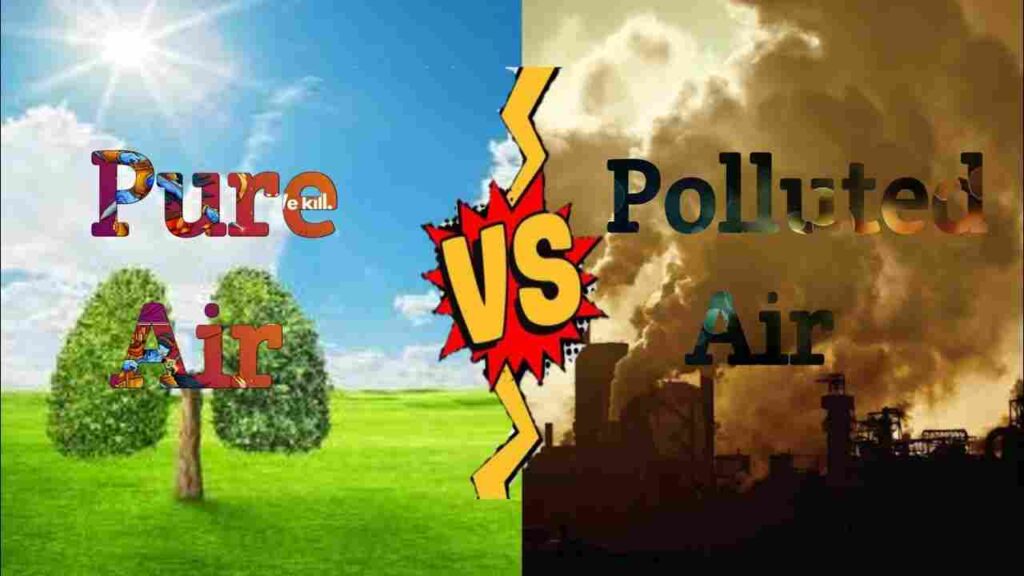
Explain the 15 Key Difference between Pure Air and Polluted Air
Pure air and polluted air are distinct in several crucial aspects, with each having a profound impact on our health and the environment. Here in this article we are going to explain the 15 difference between pure air and polluted air for your school project:
Difference between Pure Air and Polluted Air
Composition: Polluted air contains high concentrations of pollutants like particulate matter, carbon monoxide, sulphur dioxide, nitrogen oxides, and volatile organic compounds. Pure air is primarily composed of nitrogen (78%), oxygen (21%), and traces of other gases.
Health Effects: Inhaling clean air promotes general health, while breathing air that has been tainted with pollutants can cause cancer, cardiovascular disease, allergies, and respiratory diseases.
Clear visibility provided by pure air allows us to clearly see distant objects. In contrast, because of the smog, haze, and suspended particles found in polluted air, visibility is reduced.
Smell: While polluted air may contain unpleasant odours brought on by burning waste, vehicle exhaust, or industrial emissions, pure air typically has a clean, natural scent.
Pure air doesn’t appear to have any colour, which adds to the sky’s vivid hues. On the other hand, the sky may appear grey or brown due to a pollution-related tinge.
Pure air is essential for plant growth because it gives plants the carbon dioxide they need for photosynthesis. Due to plant damage from polluted air, crop yields are decreased, forests are harmed, and biodiversity is decreased.
Climate Change: By releasing greenhouse gases like carbon dioxide, polluted air causes climate change and exacerbates global warming. Clean air contributes to a stable climate.
Acid Rain: Acid rain can harm aquatic ecosystems, forests, and infrastructure when it results from air pollution containing high levels of sulphur dioxide and nitrogen oxides. Acid rain does not form in the presence of pure air.
Allergens: Typical allergens like pollen, mould spores, and dust mites are typically absent from pure air. These allergens can be present in higher concentrations in polluted air, which can cause allergic reactions in those who are susceptible.
Noise Pollution: Quiet environments are associated with clean air, whereas noisy environments are frequently associated with industrial activity, traffic, or construction.
Indoor Air Quality: While polluted indoor air can be caused by elements like inadequate ventilation, smoking, or the presence of volatile chemicals, clean indoor air promotes a healthy living environment.
Ozone Layer Depletion: The ozone layer is being destroyed by ozone-depleting chemicals like chlorofluorocarbons (CFCs), which exposes us to dangerous ultraviolet (UV) radiation. The ozone layer is not harmed by pure air.
Water Quality: Harmful pollutants from contaminated air can enter water bodies through precipitation or air-water interactions, lowering the quality of the water. Water sources can remain clean and unpolluted with the help of pure air.
In order to maintain healthy lung function and promote effective oxygen exchange, the respiratory system needs clean air. The respiratory system is irritated and harmed by polluted air, which results in respiratory illnesses and diminished lung capacity.
Overall Well-Being: Inhaling pure air improves mood, energy levels, and mental clarity. Polluted air, on the other hand, can result in fatigue, headaches, and a general malaise.
By understanding these difference between pure air and polluted air, we can appreciate the value of pure air and strive to reduce pollution levels, preserving the health of both ourselves and the planet.
Also Read: Understand the TEN Difference between Piles and Fissure